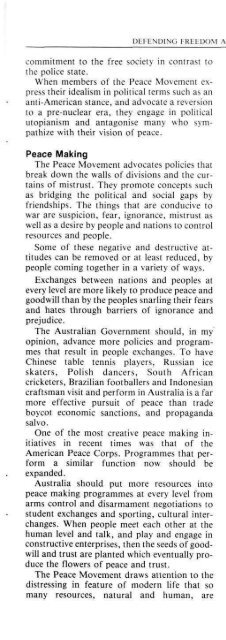ISSUE 75 : Mar/Apr - 1989 - Australian Defence Force Journal
ISSUE 75 : Mar/Apr - 1989 - Australian Defence Force Journal
ISSUE 75 : Mar/Apr - 1989 - Australian Defence Force Journal
- No tags were found...
Create successful ePaper yourself
Turn your PDF publications into a flip-book with our unique Google optimized e-Paper software.
14 DEFENCE FORCE JOURNAL No. <strong>75</strong> <strong>Mar</strong>ch/<strong>Apr</strong>il 89dogma. The rigidity of dogma inevitably leadsto failure — as history and experience show.Military operations do not aim to fail, sodogma has no place in their domain.Military doctrine is a body of central beliefsabout war that guides the application of powerin combat: it is authoritative but only a guideand requires judgement in its use. Doctrine isderived from a synergy of two sources — fundamentalprinciples and innovative ideas aboutthe best use of combat power. Fundamentalprinciples draw on experience and are timehonouredas the optimum way to succeed, or,what has worked best in the past. Conversely,innovative ideas look only to the future and includetheoretical as well as practical applications.Fundamental principles are, by nature,relatively permanent, evolving slowly, whereasinnovation embraces continuous change. Theoverall interaction of the two therefore makesmilitary doctrine a particularly dynamic processbounded only by the limits of our imagination.Air Power DoctrineWe have defined doctrine here in a generalsense, as it applies to any combat power. Airpower doctrine however has a more specificfocus. Firstly, consider what air power is. Thewidely recognised, Mason and Armitage definitionproclaims air power as;"... the ability to project military force byor from a platform in the third dimensionabove the surface of the earth."So air power doctrine can be described as thecentral beliefs about the conduct of war thatguide air services in the application of militarypower within the third dimension above the surfaceof the earth.Note that air power doctrine is not just concernedwith the air war nor confined solely toair forces. . . . Air power doctrine is about thebest use of air services to exploit the intrinsicqualities of air power in the achievement of nationalobjectives. The characteristics of airpower, its advantages and limitations, must beconveyed within the context and form of futurewarfare. While air power doctrine logically maybe based on the past and established in the present,its prime concern is with the future. LordTedder, as an exponent of air power, encapsulatedthe concept of doctrine when he stated,"We must look forward from the past . . ..not back to the past"The Shaping of Air Power Doctrine inAustraliaLet us then take Lord Tedder's advice anddwell for a moment on the historical events thathave shaped air power doctrine both globallyand nationally. In this way we will have a betterunderstanding of where RAAF doctrine is todayand where it should go from here.Throughout the relatively short history of airpower, some <strong>75</strong> years, opportunities fordevelopment of air power doctrine have beenfew. This was initially the result of a harmfuleffect on the efficacy of air power doctrine bysome over-earnest, politically motivated proponentsof air power who were actively seekingthe independence of air forces. It was also theresult of undue emphasis on air power's responsibilityto support land and maritime powers,often to the detriment of singular developmentof operations within the dimension of the air.Air power can be applied in support of othercombat powers; it can also be applied independently.Both applications are vital to anation's security, yet history suggests the latterhas received a disproportionate emphasis in thepast.An unrelated, but parallel development wasthe attitudinal change to warfare since the endof WW II. The idea of global confrontation,either conventional or nuclear, which was thedriving force behind Western military doctrineimmediately after WW II and for the next twentyyears, has steadily given way to greater emphasisnow on limited warfare. For political ormilitary reasons, modern warfare now seekslimited objectives rather than the total victoryof the past, and conflicts may take the form ofcounter-insurgency, guerrilla warfare orcounter-terrorism. The Granada invasion andthe Libya raid are examples of the modern useof combat force, and are acknowledged in today'swarfare lexicon with its reference to lowintensityconflict, or in Australia's case,escalated low-level conflict. The attitudinalchanges to warfare over the four decades sinceWW II have had a major impact on the applicationof air power.Technology too has had an impact.Technology has improved the performance ofmilitary equipment with the direct result thatnumbers of weapons and weapon systemswithin military inventories have decreased. Thishas not been without corresponding anddramatic rises in costs. Also, the cost of retain-

















